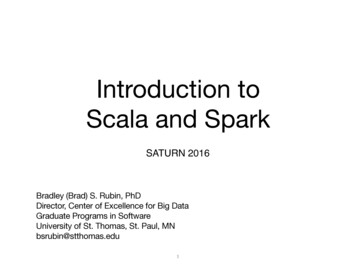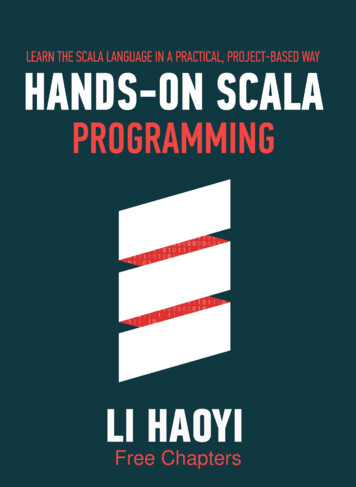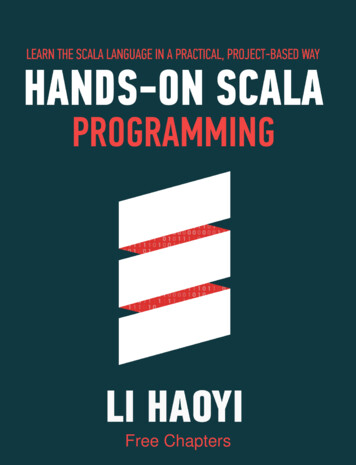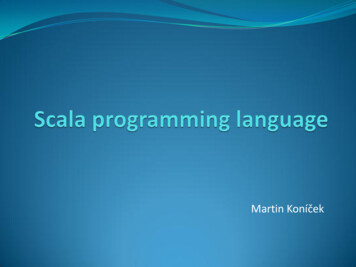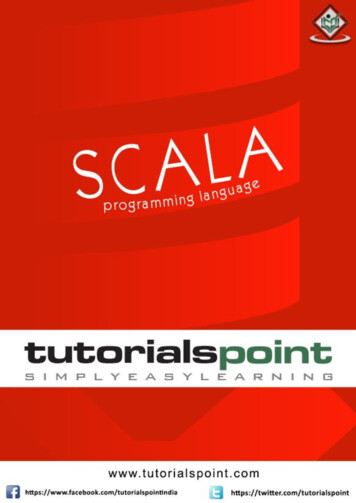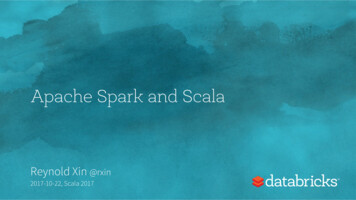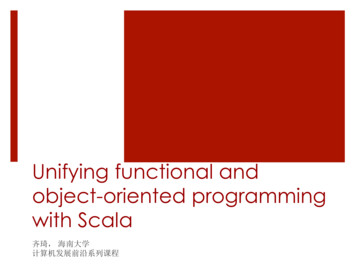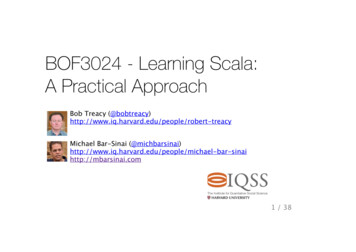
Transcription
BOF3024 - Learning Scala:A Practical ApproachBob Treacy t-‐‑treacyMichael Bar-‐‑Sinai chael-‐‑bar-‐‑sinaihttp://mbarsinai.com1 / 38
Agenda1.2.3.4.5.6.Why Scala?Colliding ConceptsNew ConceptsToolsTips or, how to learn Scala and keep your jobCase studySlides and 3024F2 / 38
Why ScalaImplement a project based on a template that's relatively close to thefinal projectSuch as Akka distributed worker templateCreate a web application using Play!has a Java flavor as well, but template engine uses Scala onlyTry some functional programmingScala may not be your best choiceTry some postfunctional programmingIf you look at the features Scala provides, it is substantially afunctional language, but. it does not force you to adopt thefunctional style. I think postfunctional is a good term for thatblend.Martin Odersky, one's favorite reasons:Learn a new and interesting languageBend your mind in new ways.Just because3 / 38
Colliding ConceptsWhile sharing the JVM, and Java's extensive libraries, Scala and Java are verydifferent languages. Some words have different meanings.Intuitions created by years of working with Java can be misleading. You mayend up doing as much unlearning as you do learning.It's a good thing, if you're ready for it.So We've gathered a few examples.4 / 38
SyntaxCollidingConceptsSemicolon inferenceSemi-‐‑colons are optional at the end of a line containing an expressionTwo expressions, two linesprint("hello, ")println("world!")Two expressions, one lineprint("hello, "); println("world!")One expression, multiple lines: a line ending is treated as a semicolonunless:1. End in a word that would not be legal at the end of a expression2. Next line begins with a word that cannot start a expression3. Line ends while inside parentheses or bracket5 / 38
SyntaxCollidingConcepts[]s, ()s and {}s[] are for type parameters, are for XML literals and operators, () and {}are interchangeable. Array access is done using array(index), not array[index]!6 / 38
SyntaxCollidingConceptsType name goes after the variable nameJava:Scala:String myString;myString: StringPersonal goal: stop getting confused as early as Q3 of 2041.However, declaring a value's type is not always necessary -‐‑ in many casesScala can infer types on its own:val myString "Hello!" //myString is a String7 / 38
Constructors, ReconstructedCollidingConceptsUnlike Java, each class has a single primary constructor, whose definitiondovetails the class' definition:class BOF( var title:String,val num:Int,topic: String ) {def desc title ", a BOF about " topic}var v:T becomes a mutable field of the classval v:T becomes a final field of the classv:T is a value that can be used inside the classThe body of the primary constructor is all the code directly within theclass.Alternative description (Odersky):Classes have parameters, just like methods do.8 / 38
Auxiliary ConstructorsCollidingConceptsIt is also possible to define auxiliary constructors.Auxiliary Constructors:Are called this(.)Have to begin by calling the primary constructor, or another auxiliaryconstructor.Either way, that constructor is referred to as this.class Bof( var title:String,val num:Int,topic: String ) {def desc title ", a BOF about " topicdef this( title:String ) {this( title, title.size, "the topic of '%s'".format(title))}}9 / 38
Method invocationCollidingConceptsMethods that take no parameters may be invoked by just calling them -‐‑no need for () after the name.scala def f() { println("hello") }f: ()Unitscala f // prints "hello"scala f() // prints "hello"scala fres9: () Unit function0 Single parameter methods can be invoked using an alternative to thedot-‐‑notation:a b is the same as a. (b)Right associative methods: When last character of method name is :a : b is the same as b. :(a)The apply() method -‐‑ creates a "default" method for objects -‐‑ no needto type the apply part.instance() is really instance.apply which is reallyinstance.apply()scala (f )() // prints "hello"10 / 38
The Point of No returnCollidingConceptsAll methods return values. Thus, the return keyword is oftensuperfluous.In the absence of an explicit return keyword, a method will return the lastvalue computed.return is useful as a type of break that returns a value.These samples are functionally the same:class SumWithInt {var sum 0def add(b: Int):Int {sum breturn sum}def add1( i:Int ) {sum isum}}Code: Returns.scala at presentation repo11 / 38
Unit filling the voidCollidingConceptsAll methods return values. Thus, declaring a method to be of a void typeis impossible.Method that has nothing to return, can return Unit, a type with a singlevalue, marked as (). This allows everything to be an expression -‐‑ Scala hasno statements.These samples are functionally the same:class SumWithUnit {var sum 0def add(b: Int): Unit {sum breturn ()}def add1( i:Int ) {sum i()}def add2( i:Int ) {sum i}def add3( i:Int ) sum i}Code: Returns.scala at presentation repo12 / 38
class vs. objectCollidingConceptsUsing the object keyword, programs can declare and construct an instanceat design time. This is different from the class keyword, where instanceconstruction is done at runtime, using the new keyword.object Counter {var count new java.util.concurrent.atomic.AtomicInteger(0)def up() count.addAndGet(1)def down() count.addAndGet(-1)def value count.get}scala Counter.upres5: Int 1The created object is a singleton, initialized the first time its called.Objects can extend classes, and traits, as usual.The object's type is implicitly defined, but can be accessed (e.g. whencreating DSLs).13 / 38
Companion Objects replacestaticCollidingConceptsThere is no static class members in Scala. Functionality that belongs to aclass (rather than to its instances) goes in that class' Companion Object.class Burrito private( val filling:String ) { . }object Burrito {var count new java.util.concurrent.atomic.AtomicInteger(0)def makeWith( filling:String ) {count.incrementAndGet()new Burrito(filling)}def brag() "%,d burritos served".format(count.get)}scala res22:.scala res14:Burrito makeWith "beans"Burrito Burrito with beansBurrito.bragString 6 burritos served14 / 38
apply() is the new newCollidingConceptsDefine an apply method on a companion object, and you can skip new:object Burrito {var count new java.util.concurrent.atomic.AtomicInteger(0)def makeWith( filling:String ) {count.incrementAndGet()new Burrito(filling)}def apply( filling:String ) makeWith(filling)///.}scala Burrito("Everything")res28: Burrito Burrito with Everything15 / 38
Starting an ApplicationCollidingConceptsNo static No public static void main.Implementing the App trait turns objects into executable applications. Ituses the body of the object as a main method.object MyApplication extends App {if (args.contains("-h")) printHelpAndQuit();// rest of code goes here}To access the argument list, use args.There is a main method -‐‑ normally, it does not need to be explicitlyoverridden.The object's fields will not be initialized when the object's body isexecuted.Trait Application is deprecated as of version 2.9.016 / 38
Collection LibraryScala's collection library is very different from Java's. Scala approach tocollections is different.Most collections have a mutable and immutable version. Same name,different package.If the package is not imported or the full name is not used, defaultis immutable versionJava collections have minimal API, whereas Scala's collections has largeAPIjava.util.List doesn't have a last() method, as it can beimplemented by size() and get()This may be one of the areas where it's simpler to read the official introrather than learn as you ections/introduction.html17 / 38
What Do Mean By List?Java's ListOrdered collection of elements.Scala's ListThe classic linked list from CS 101 / intro to functional programming (withsome extras thrown in, and without the annoying TA).When you want a Java type of List, use Scala's Seq or Buffer18 / 38
New ConceptsScala introduces many concepts that are not present in Java. Often, whenyou look at Scala code, it's unclear where values come from, how can objectsextends so many classes, and so on.This confused us too.So We've gathered a few examples.19 / 38
val vs. varNewConceptsval -‐‑ immutable valuevar -‐‑ variable (mutable value)def -‐‑ defines methods, but can also be used to define immutablevalues.Immutability bias -‐‑ when possible, use immutable values and datastructures.val workerId UUID.randomUUID().toStringvar currentWorkId: Option[String] None20 / 38
Traits, not InterfacesNewConceptsTraits define signatures of supported methods, like Java interfaces, but canalso provide method implementations and fields.trait Foo {def bar( b:Baz )}They can also be "mixed in" to create quasi-‐‑multiple inheritancetrait Fudge {def drip(s:Shirt) {.}}trait Sprinklestrait Peanutsclass Foodclass IceCream extends Foodclass TraitTest {var desert new IceCream with Fudge with Sprinkles with Peanuts}21 / 38
Case ClassesNewConceptsA class that's specialized for storing compound immutable values. Bydeciding to use a case class rather than a normal class, you get:Automatic, proper toString, equals, hashCode, getters.copy method to create new objects based on existing ones.Companion object, complete with apply and unapply methodsabstract class :Int, title:String) extends SessionTutorial(num:Int, technology:String) extends SessionKeynote( title:String, speaker:String ) extends SessionJUG( groupName: String ) extends Sessionscala val jos BOF(3024,"Learning Scala the Practical Way")jos: BOF BOF(3024,Learning Scala the Practical Way)scala val jos2 jos.copy( num 1024 )jos2: BOF BOF(1024,Learning Scala the Practical Way)22 / 38
Pattern MatchingNewConceptsobject SessionPrinter {def print(s:Session) {s match {case BOF(n,t) "%d: BOF %s".format(n,t)case Tutorial(n,t) "Learn about %s! (%d)".format(t,n)case JUG(g) "Meet with friends from %s".format(g)case s.toString}}}scala val mySched Seq( BOF(1,"Learn Scala"), Tutorial(40,"NetBeans"), JUG(scala mySched.map( SessionPrinter.print( ) ).foreach( println( ) )1: BOF Learn ScalaLearn about NetBeans! (40)Meet with friends from jArgentina JUGPattern matching is a very versatile control structure, whose full options arebeyond the scope of this talk. In short, it the mother of all switchstatements. And then some.23 / 38
ImplicitsNewConceptsimplicit keywordimplicit conversionif compiler comes across a type error it will look for an appropriateconversion methodwhen you wish you could add a method to a class you didn't writeimplicit parametersarguments to a method call can be left outcompiler will look for default values to supply with the function call24 / 38
Not CoveredNewConceptsScala has many other new concept we can't cover here, but are worthlooking into:Option typeEither typeScoping of private field modifiersVarious import optionsDelimited ContinuationsMacrosRich type systemCurryingWorking with functionsAdvanced pattern matchingTuples 25 / 38
Toolsscala REPL -‐‑ play around with codeIDEsNetBeans -‐‑ Scala PluginIntellij IDEAEclipseOr, text editors such as SublimeText, AtomScalaDoc26 / 38
ToolsSBTimport com.github.retronym.SbtOneJar.name : "galileowrapper"version : "1.0"scalaVersion : "2.10.3"libraryDependencies Seq("com.typesafe.akka" %% "akka-contrib" % "2.2.1",."edu.harvard.iq" % "consilience-core" % "1.0-SNAPSHOT","junit" % "junit" % "4.4")resolvers Seq("Typesafe Repository" Local Maven Repository" at"file://" Path.userHome.absolutePath "/.m2/repository")oneJarSettingsmainClass in oneJar : Some("worker.Main")27 / 38
TipsT ip sSpotting a good starter projectLook at activator templatesOne-‐‑offsScriptsResourcesBooksScala for the impatient by Cay S. Horstmann 1 chapter per lunch, andyou're done in 22 business days.MeetupsTypesafeWebcasts, NewslettersDZone Refcard (Scala Akka)MOOCs28 / 38
Don't Believe Everything YouHear About FPT ip sFunctional programming is great for some things, and not-‐‑so-‐‑great forothers. It is somewhat hyped at the moment.Scala, a postfunctional language, allows you to choose the approach youdeem best, or just feel like trying. Don't be confused by the internets.Mutability is OK, as long as there's no concurrent updatesjava.util.concurrent is still there for youObject creation and clean-‐‑up may be cheap, but it's not free!Side-‐‑effects are hard to reason about formally. This is why we stillhave jobs.Tail recursion is not the best thing since sliced breadIt's a way to coerce an recursive algorithm into a shape that willallow the compiler to further coerce it into a loop.Makes total sense in Lisp, ML etc. where there are no loops.You're writing in Scala. You can actually use a loop.When you do use a tail recursion, don't forget @tailrec.Having said that.29 / 38
Ease Into FunctionalProgrammingT ip sAt your leisure, consider re-‐‑writing existing, "Scala-‐‑with-‐‑Java-‐‑accent" codeusing functional programming idioms.Case study: Re-writing in ScalaProblem: Create a poor-‐‑man's Markdown to HTML conversion, supporting p s and single level ul s.Input: Sequence of Strings in markdown syntaxLines starting with * should become li s, grouped and nested in a ul element.Output: Sequence of p and ul elements, according to Markdown rules.30 / 38
Initial code:def html1( rawStrings : Seq[String] ):String {val cleaned mutable.Buffer[String]()for ( l - rawStrings ) {cleaned l.trim}val curUl mutable.Buffer[String]()val html mutable.Buffer[String]()for ( l - cleaned ) {if ( l.startsWith("*") ) {curUl " li " l.substring(1).trim " /li "} else {if ( ! curUl.isEmpty ) {html " ul " curUl.mkString " /ul "curUl.clear}html " p " l " /p "}}CodeRewriteif ( ! curUl.isEmpty ) {html " ul " curUl.mkString " /ul "}return html.mkString}Code: Rewrite.scala in presentation repo31 / 38
Initial code:def html1( rawStrings : Seq[String] ):String {val cleaned mutable.Buffer[String]()for ( l - rawStrings ) {cleaned l.trim}val curUl mutable.Buffer[String]()val html mutable.Buffer[String]()for ( l - cleaned ) {if ( l.startsWith("*") ) {curUl " li " l.substring(1).trim " /li "} else {if ( ! curUl.isEmpty ) {html " ul " curUl.mkString " /ul "curUl.clear}html " p " l " /p "}}CodeRewriteif ( ! curUl.isEmpty ) {html " ul " curUl.mkString " /ul "}return html.mkString}32 / 38
Somewhat more functional:def html2( rawStrings : Seq[String] ) {val cleaned rawStrings.map( .trim )CodeRewriteval curUl mutable.Buffer[String]()val html mutable.Buffer[String]()for ( l - cleaned ) {if ( l.startsWith("*") ) {curUl " li " l.substring(1).trim " /li "} else {if ( ! curUl.isEmpty ) {html " ul " curUl.mkString " /ul "curUl.clear}html " p " l " /p "}}if ( ! curUl.isEmpty ) {html " ul " curUl.mkString " /ul "}html.mkString}33 / 38
Somewhat more functional:def html2( rawStrings : Seq[String] ) {val cleaned rawStrings.map( .trim )CodeRewriteval curUl mutable.Buffer[String]()val html mutable.Buffer[String]()for ( l - cleaned ) {if ( l.startsWith("*") ) {curUl " li " l.substring(1).trim " /li "} else {if ( ! curUl.isEmpty ) {html " ul " curUl.mkString " /ul "curUl.clear}html " p " l " /p "}}if ( ! curUl.isEmpty ) {html " ul " curUl.mkString " /ul "}html.mkString}34 / 38
Somewhat more functional:def html2( rawStrings : Seq[String] ) {val cleaned rawStrings.map( .trim )CodeRewriteval curUl mutable.Buffer[String]()val html mutable.Buffer[String]()for ( l - cleaned ) {if ( l.startsWith("*") ) {curUl " li " l.substring(1).trim " /li "} else {if ( ! curUl.isEmpty ) {html " ul " curUl.mkString " /ul "curUl.clear}html " p " l " /p "}}Seq(1,2,3,4).foldLeft(0)( (p,i) p i )// yields 10if ( ! curUl.isEmpty ) {html " ul " curUl.mkString " /ul "}html.mkString}35 / 38
Even more functional:CodeRewritedef html3( rawStrings : Seq[String] ) {val elements rawStrings.map( .trim ).map( s if (s.startsWith("*")){" li " s.substring(1).trim " /li "}else{" p " s " /p "} )val grouped elements.tail.foldLeft( List(List(elements.head)) )((l,s) {if ( l.last.head(1) ! s(1) )l : List(s)elsel.dropRight(1) : (l.last : s)})grouped.flatMap( l if (l.head.startsWith(" li "))List(" ul " l.mkString " /ul ")elsel ).mkString}Using foldLeft, we create a list of lists of Strings, and operate on them.Then, use flatMap to convert the result to a list of strings, and then usemkString to create the final string.Actual code included in presentation repo at GitHub.36 / 38
Other SessionsScalaCON1740 -‐‑ Scala Macros: What Are They, How Do They Work,and Who Uses Them? Thursday, Oct 2, 11:30 AM -‐‑ 12:30 PM -‐‑Hilton -‐‑ Continental Ballroom 7/8/9CON1849 -‐‑ Event-‐‑Sourced Architectures with Akka Wednesday,Oct 1, 8:30 AM -‐‑ 9:30 AM -‐‑ Hilton -‐‑ Continental Ballroom 7/8/9IQSSBOF5619 -‐‑ Lean Beans (Are Made of This): Command PatternVersus MVCBOF5475 When The PrimeFaces Bootstrap Theme Isnʼ’t EnoughTuesday, Sep 30, 9:00 PM -‐‑ 9:45 PM -‐‑ Hilton -‐‑ Plaza ACON5575 Bean Validation: Practical Examples from a Real WorldJava EE7 ApplicationTuesday, Sep 30, 4:00 PM -‐‑ 5:00 PM -‐‑ Parc 55 -‐‑ Cyril Magnin I37 / 38
ThanksVisit the IQSS data science team at http://datascience.iq.harvard.eduPresentation created using remark.js.38 / 38
Scala's collection library is very different from Java's. Scala approach to collections is different. Most collections have a mutable and immutable version. Same name, different package. If the package is not imported or the full name is not used, default is immutable version Java collections have minimal
